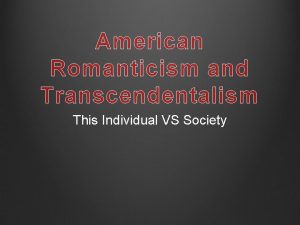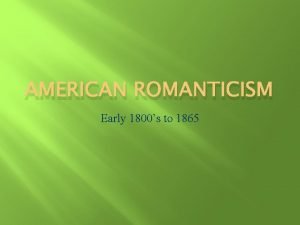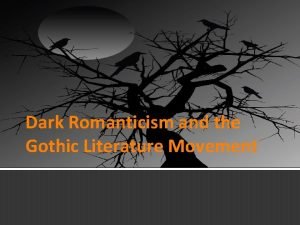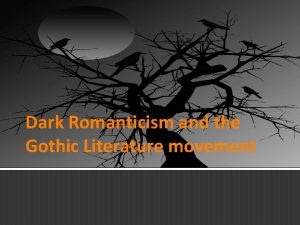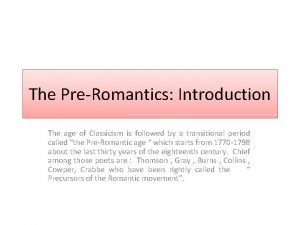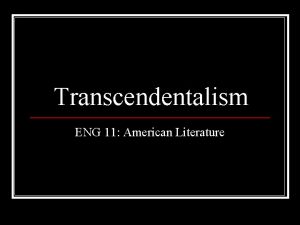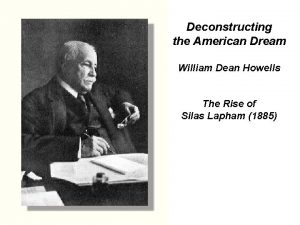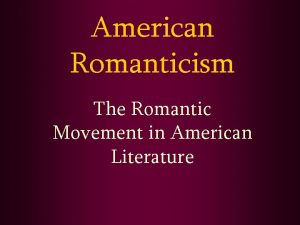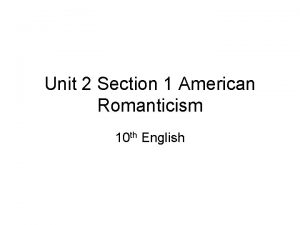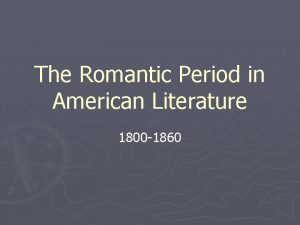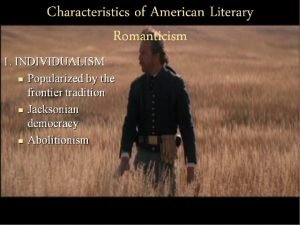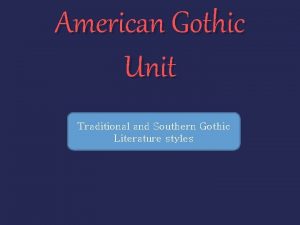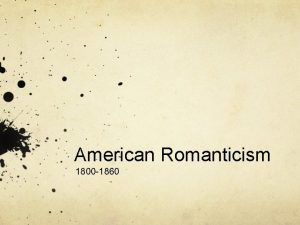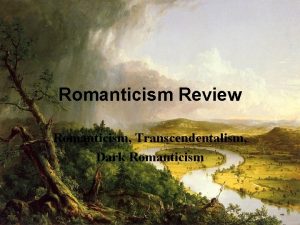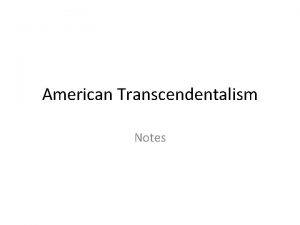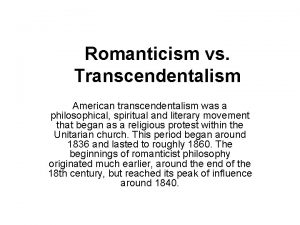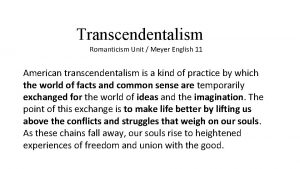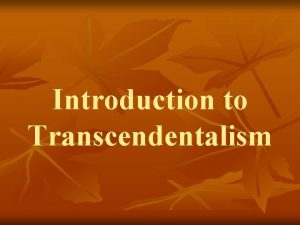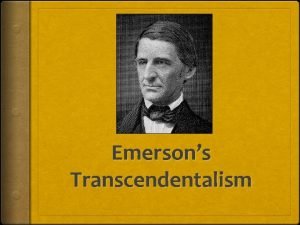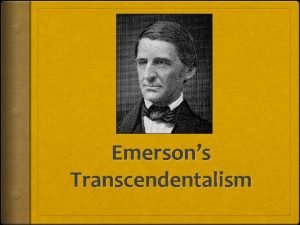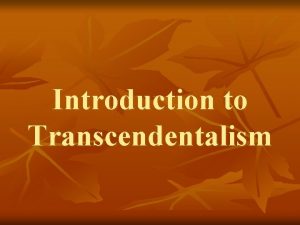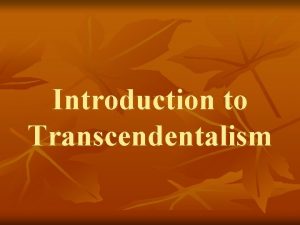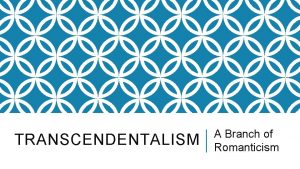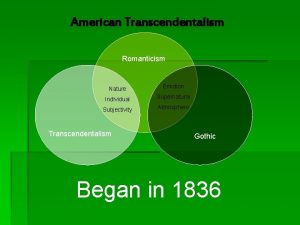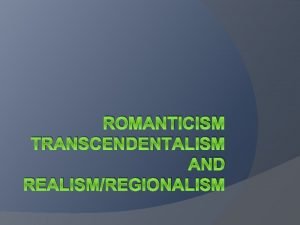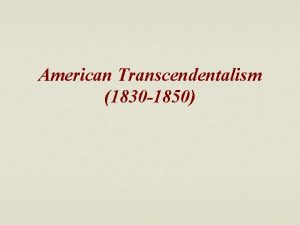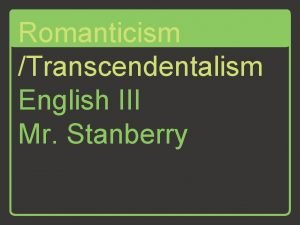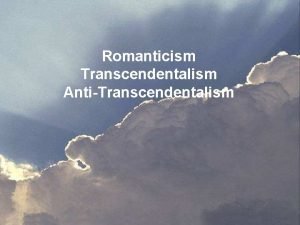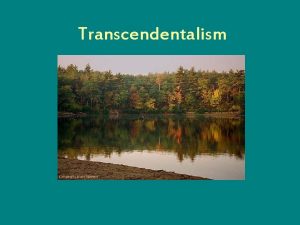American Romanticism and Transcendentalism This Individual VS Society

















- Slides: 17

American Romanticism and Transcendentalism This Individual VS Society

Context American Romanticism is rooted in Europe and is the antithetical response to the Age of Enlightenment with its emphasis on science and reason. Romantics sought truth through intuition, nature, and self-reflection.


Characteristics of American Romanticism Offer a high level of moral enthusiasm and expression Emphasize the importance of the individual over the collective/ society View society and its institutions as being inherently corrupt and out of synch with man’s natural state Value intuitive perception over reason Emphasize imagination and the unfolding of the self Value the supernatural and the exotic See the artist as supreme (especially the poet) More often take on a Gothic character Mythologize the frontier and the American Indian Gives rise to Transcendentalism

“Romanticism is precisely situated neither in choice of subject nor exact truth, but in the way of feeling. ” -Charles Baudeliare

Characteristics of the Romantic Hero Rejects established norms and conventions of behavior Often shunned by society Often introspective, emphasizing the self Wanderlust, a desire to travel, to see the world Often express regret for wrong actions, self-criticism leading to philanthropy Birth and class are unimportant Eccentric moral codes


That delicate forest flower, With scented breath and look so like a smile, Seems, as it issues from the shapeless mould, An emanation of the indwelling Life, A visible token of the upholding Love, That are the soul of this great universe. -William Cullen Bryant

Significant Works of American Romanticism Nathaniel Hawthorne – The Scarlet Letter Edgar Allan Poe – “The Raven”, “Fall of the House of Usher” Washington Irving – “Legend of Sleepy Hollow”, “Rip Van Winkle Walt Whitman – “Leaves of Grass” Herman Melville – Moby Dick James Fennimore Cooper – Last of the Mohicans Henry Wadsworth Longfellow – “Paul Revere’s Ride” Harriet Beecher Stowe – Uncle Tom’s Cabin

“Nature is a revelation of God; art is a revelation of man. ” -Henry Wadsworth Longfellow

The Romantic Dichotomy Emerging from the Romantic movement are two distinct branches of thought: Transcendentalism Dark Romanticism

Transcendentalism Though opposed to the ideas of predetermination, Romanticism primarily comes about as a response to the dominant forces of the Enlightenment era – rationalism and scientific advancement; Transcendentalism, however, emerges most directly as a rebellion against Calvinism and the rigid dogma of the Church. Philosophically, the central ideas of Transcendentalism had been around since German philosopher, Emmanuel Kant, first coined the term in the 18 th century. In America, Ralph Waldo Emerson (1803 – 1882) is considered the strongest voice of the Transcendental movement. Emerson borrows much from the philosophy of Kant as well as from Eastern spiritual traditions and filters them through his unique perspective and experiences; he was the son of a Unitarian minister, graduated Harvard at 18, publishes his first Transcendentalist work, “Nature” in 1836.

Transcendentalism Vs. Romanticism Both: Movements born as a reaction to strict traditions, laws, and religious dogma Reject Calvinism and the doctrine of predetermination Emphasize the importance of the individual Look to Nature as a source of inspiration and spirituality See society as inherently corrupt Transcendentalists: Stress the spiritual Espouse the belief that all aspects of nature, including man, are expressions of God; all things are divine; all individuals have an inner-goodness; one’s intuition is an expression of the inner light of God Romantics: Like transcendentalists, Romantics see nature as divine; however they assert that man is not inherently divine, but is capable of divinity the closer he/she gets to nature and the further removed from society; his/her moral life must be directed toward the divine

Ralph Waldo Emerson “Whoso would be a man must be a nonconformist. ” -From “Self. Reliance” “Build therefore your own world. ” -From “Nature”

Dark Romanticism Characterized by writers such as Nathaniel Hawthorne, Herman Melville, and Edgar Allan Poe Notably less optimistic than Transcendentalists regarding mankind, nature, and divinity Dark Romantics present individuals prone to self-destruction and sin; they are not inherently in possession of divinity or wisdom Adapted images of anthropomorphized evil (Satan, devils, ghosts, vampires, ghouls, witches, and other supernatural forces) as emblematic of certain aspects of human nature Tends to portray characters who fail to make a positive and proactive change in their tragic trajectory

Nathaniel Hawthorne 1804 -1864 • Born in Salem, Massachusetts • Related to John Hathorne, the only judge involved in the Salem Witch Trials • Along with Poe and Melville, considered a “Dark Romantic” • Dark Romantics see man as prone to sin and self-destruction and not inherently divine • Important Novels: • The Scarlet Letter (1850) • The House of the Seven Gables (1851) • Important short-stories: • “Young Goodman Brown” • “The Minister’s Black Veil” • “The Ambitious Guest”

Cite two examples of a modern-day Romantic hero and explain how they meet the necessary criteria.
 American romanticism and transcendentalism
American romanticism and transcendentalism Literary focus transcendentalism and romanticism answer key
Literary focus transcendentalism and romanticism answer key Elements of dark romanticism
Elements of dark romanticism Transcendentalism vs dark romanticism venn diagram
Transcendentalism vs dark romanticism venn diagram Dark romanticism characteristics
Dark romanticism characteristics Transcendentalism vs dark romanticism
Transcendentalism vs dark romanticism Pre romanticism
Pre romanticism The romanticism (1795 — 1835) what is romanticism
The romanticism (1795 — 1835) what is romanticism Transcendentalism american literature
Transcendentalism american literature American romanticism characteristics
American romanticism characteristics American gothic romanticism
American gothic romanticism Authors of american romanticism
Authors of american romanticism Unit 2 lesson 1 american romanticism
Unit 2 lesson 1 american romanticism Romantic period american literature
Romantic period american literature Individualism in romanticism
Individualism in romanticism Southern gothic tradition
Southern gothic tradition Romanticism period in american literature
Romanticism period in american literature American romanticism 1800 to 1860 worksheet answers
American romanticism 1800 to 1860 worksheet answers
